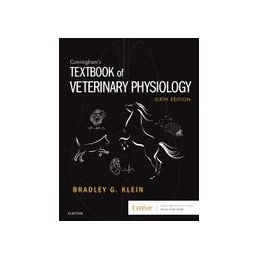- Reduced price

Order to parcel locker

easy pay


 Delivery policy
Delivery policy
Choose Paczkomat Inpost, Orlen Paczka, DHL, DPD or Poczta Polska. Click for more details
 Security policy
Security policy
Pay with a quick bank transfer, payment card or cash on delivery. Click for more details
 Return policy
Return policy
If you are a consumer, you can return the goods within 14 days. Click for more details
Learn how to understand normal body functions before learning about the mechanisms of veterinary disease. Cunninghams Textbook of Veterinary Physiology, 6th Edition approaches this vast subject in a practical, user-friendly way that helps you grasp key concepts and learn how they relate to clinical practice. From cell physiology to body system function to homeostasis and immune function, this comprehensive text provides the solid foundation needed before advancing in the veterinary curriculum.
Data sheet
Section I: The Cell 1. The Molecular and Cellular Bases of Physiological Regulation 2. Cancer: A Disease of Cellular Proliferation, Life Span, and Death
Section II: Neurophysiology 3. Introduction to the Nervous System 4. The Neuron 5. The Synapse 6. The Physiology of Muscle 7. The Concept of a Reflex 8. Skeletal Muscle Receptor Organs 9. The Concept of Lower and Upper Motor Neurons and Their Malfunction 10. The Central Control of Movement 11. The Vestibular System 12. The Cerebellum 13. The Autonomic Nervous System 14. The Visual System 15. Cerebrospinal Fluid and the Blood-Brain Barrier 16. The Electroencephalogram and Sensory-Evoked Potentials 17. Hearing
Section III: Cardiovascular Physiology 18. Overview of Cardiovascular Function 19. Electrical Activity of the Heart 20. The Electrocardiogram 21. The Heart as a Pump 22. The Systemic and Pulmonary Circulations 23. Capillaries and Fluid Exchange 24. Local Control of Blood Flow 25. Neural and Hormonal Control of Blood Pressure and Blood Volume 26. Integrated Cardiovascular Responses
Section IV: Physiology of the Gastrointestinal Tract 27. Regulation of the Gastrointestinal Functions 28. Motility Patterns of the Gastrointestinal Tract 29. Secretions of the Gastrointestinal Tract 30. Digestion and Absorption: The Nonfermentative Processes 31. Digestion: The Fermentative Processes 32. Postabsorptive Nutrient Utilization
Section V: Endocrinology 33. The Endocrine System 34. Endocrine Glands and Their Function
Section VI: Reproduction and Lactation 35. Control of Gonadal and Gamete Development 36. Control of Ovulation and the Corpus Luteum 37. Reproductive Cycles 38. Pregnancy and Parturition 39. The Mammary Gland 40. Reproductive Physiology of the Male
Section VII: Renal Physiology 41. Glomerular Filtration 42. Solute Reabsorption 43. Water Balance 44. Acid-Base Balance
Section VIII: Respiratory Function 45. Overview of Respiratory Function: Ventilation of the Lung 46. Pulmonary Blood Flow 47. Gas Exchange 48. Gas Transport in the Blood 49. Control of Ventilation 50. Nonrespiratory Functions of the Lung
Section IX: Homeostasis 51. Fetal and Neonatal Oxygen Transport 52. Acid-Base Homeostasis 53. Thermoregulation
Section X: The Immune System 54. Antigens and Innate Immunity 55. The Specific Immune Response: Acquired Immunity
Appendix A: Answers to Practice Questions
Reference: 17730
Author: Abul K. Abbas
